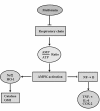Neuropharmacological Actions of Metformin in Stroke
- PMID: 26411966
- PMCID: PMC4812800
- DOI: 10.2174/1570159x13666150205143555
Neuropharmacological Actions of Metformin in Stroke
Abstract
Increasing epidemiologic evidence suggests that metformin, a well-established AMPK activator and the most favorable first-line anti-diabetic drug, reduces stroke incidence and severity. However, the mechanism for this remains unclear. Moreover, previous experimental studies have reported controversial results about the effects of metformin on stroke outcomes during the acute phase. However, recent studies have consistently suggested that AMPK-mediated microglia/macrophage polarization and angioneurogenesis may play essential roles in metformin-promoted, long-term functional recovery following stroke. The present review summarizes the neuropharmacological actions of metformin in experimental stroke with an emphasis on the recent findings that the cell-specific effects and duration of AMPK activation are critical to the effects of metformin on stroke outcomes.
Figures
Similar articles
-
Improvement of functional recovery by chronic metformin treatment is associated with enhanced alternative activation of microglia/macrophages and increased angiogenesis and neurogenesis following experimental stroke.Brain Behav Immun. 2014 Aug;40:131-42. doi: 10.1016/j.bbi.2014.03.003. Epub 2014 Mar 12. Brain Behav Immun. 2014. PMID: 24632338
-
Effects of metformin in experimental stroke.Stroke. 2010 Nov;41(11):2645-52. doi: 10.1161/STROKEAHA.110.589697. Epub 2010 Sep 16. Stroke. 2010. PMID: 20847317 Free PMC article.
-
Metformin reduces morphine tolerance by inhibiting microglial-mediated neuroinflammation.J Neuroinflammation. 2016 Nov 17;13(1):294. doi: 10.1186/s12974-016-0754-9. J Neuroinflammation. 2016. PMID: 27855689 Free PMC article.
-
[Metformin as a key to alternative activation of microglia?].Postepy Hig Med Dosw (Online). 2014 Mar 7;68:247-57. doi: 10.5604/17322693.1093217. Postepy Hig Med Dosw (Online). 2014. PMID: 24662793 Review. Polish.
-
[Effectiveness of metformin in prevention of development of hyperglycemia and neuronal damage caused by ischemic stress].Yakugaku Zasshi. 2011 Apr;131(4):533-8. doi: 10.1248/yakushi.131.533. Yakugaku Zasshi. 2011. PMID: 21467792 Review. Japanese.
Cited by
-
Neuro-Protective Role of Metformin in Patients with Acute Stroke and Type 2 Diabetes Mellitus via AMPK/Mammalian Target of Rapamycin (mTOR) Signaling Pathway and Oxidative Stress.Med Sci Monit. 2019 Mar 25;25:2186-2194. doi: 10.12659/MSM.911250. Med Sci Monit. 2019. PMID: 30905926 Free PMC article. Clinical Trial.
-
The Impact of Genetically Proxied AMPK Activation, the Target of Metformin, on Functional Outcome Following Ischemic Stroke.J Stroke. 2023 May;25(2):266-271. doi: 10.5853/jos.2022.03230. Epub 2023 May 30. J Stroke. 2023. PMID: 37282373 Free PMC article.
-
A comprehensive review of stroke-related signaling pathways and treatment in western medicine and traditional Chinese medicine.Front Neurosci. 2023 Jun 7;17:1200061. doi: 10.3389/fnins.2023.1200061. eCollection 2023. Front Neurosci. 2023. PMID: 37351420 Free PMC article. Review.
-
The Role and Mechanism of Metformin in the Treatment of Nervous System Diseases.Biomolecules. 2024 Dec 10;14(12):1579. doi: 10.3390/biom14121579. Biomolecules. 2024. PMID: 39766286 Free PMC article. Review.
-
Metformin effects on brain development following cranial irradiation in a mouse model.Neuro Oncol. 2021 Sep 1;23(9):1523-1536. doi: 10.1093/neuonc/noab131. Neuro Oncol. 2021. PMID: 34042964 Free PMC article.
References
-
- Halpin H.A., Morales-Suárez-Varela M.M., Martin-Moreno J.M. Chronic disease prevention and the new public health. Public Health Rev. 2010;32:125–154.
-
- Nathan D.M., Buse J.B., Davidson M.B., Ferrannini E., Holman R.R., Sherwin R., Zinman B., American Diabetes Association. European Association for the Study of Diabetes Medical management of hyperglycaemia in type 2 diabetes mellitus: a consensus algorithm for the initiation and adjustment of therapy: a consensus statement from the American Diabetes Association and the European Association for the Study of Diabetes. Diabetologia. 2009;52(1):17–30. doi: 10.1007/s00125-008-1157-y. - DOI - PubMed
Publication types
MeSH terms
Substances
LinkOut - more resources
Full Text Sources
Medical

